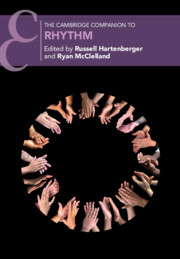Book contents
- The Cambridge Companion to Rhythm
- Cambridge Companions to Music
- The Cambridge Companion to Rhythm
- Copyright page
- Contents
- Figures
- Tables
- Music Examples
- Notes on Contributors
- Acknowledgments
- Introduction
- Part I Overview of Rhythm
- 1 Rhythm in Western Music
- 2 Perception of Rhythm
- Part II Performing Rhythm
- Part III Composing with Rhythm
- Part IV Rhythm in Jazz and Popular Music
- Part V Rhythm in Global Musics
- Part VI Epilogue
- Select Bibliography
- Index
2 - Perception of Rhythm
from Part I - Overview of Rhythm
Published online by Cambridge University Press: 18 September 2020
- The Cambridge Companion to Rhythm
- Cambridge Companions to Music
- The Cambridge Companion to Rhythm
- Copyright page
- Contents
- Figures
- Tables
- Music Examples
- Notes on Contributors
- Acknowledgments
- Introduction
- Part I Overview of Rhythm
- 1 Rhythm in Western Music
- 2 Perception of Rhythm
- Part II Performing Rhythm
- Part III Composing with Rhythm
- Part IV Rhythm in Jazz and Popular Music
- Part V Rhythm in Global Musics
- Part VI Epilogue
- Select Bibliography
- Index
Summary
Music is an essentially temporal experience, and the temporal structures by which music unfolds are critical to listeners’ aesthetic, emotional, and behavioral responses. Music is perceived at multiple related timescales, from notes to measures to phrases. In our usage, rhythm refers to the absolute timing of individual notes or sounds, beat refers to the perceived regular pulse that listeners tend to feel and synchronize their movements with, and meter is the repeating cycle of beats, often a pattern of variable salience (composed of stronger and weaker beats). The beat tends to be steady or theoretically isochronous (evenly spaced), although human performance of music inevitably adds temporal variability, via both musical intention (e.g., rubato, expressively stretching and compressing the beat rate) and natural performance dynamics (e.g., due to the limits of temporal precision of human movements). Importantly, beat and meter perception can differ between listeners, relating to factors such as musical context, expertise, cultural experience, or cognitive processes such as attention.
- Type
- Chapter
- Information
- The Cambridge Companion to Rhythm , pp. 20 - 38Publisher: Cambridge University PressPrint publication year: 2020
- 1
- Cited by

